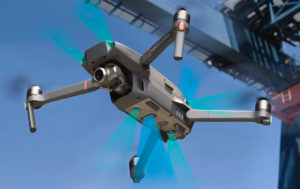
The Inspire 1 was a revelation. The first filmmaking drone in the world to integrate an HD video transmission system, 360° rotating gimbal and a 4K camera, as well as the simplicity of app control. The launches of the Zenmuse X5 and X5R cameras further cemented the Inspire as a critical tool for filmmakers around the globe.
The Inspire 2 takes everything that was good about the Inspire 1 and improves it. The image processing system CineCore2.0 has been upgraded to CineCore2.1, recording video at up to 6K in CinemaDNG/RAW and 5.2K in Apple ProRes when used with Zenmuse X7 camera. It goes from 0 to 50 mph (80 kph) in just 5 seconds and hits a maximum speed of 58 mph (94 kph) and has a max descent speed of 9m/s for unheard of speed and agility in an aircraft this size. A dual battery system prolongs the flight time to a maximum of 27 minutes (with an X4S), while self-heating technology allows it to fly even in low temperatures. FlightAutonomy has been revised and developed specifically for the Inspire 2, providing two directions of obstacle avoidance and sensor redundancy. Increased intelligence adds multiple intelligent flight modes, including Spotlight Pro, giving even single pilots the ability to create complex, dramatic shots.
An upgraded video transmission system is now capable of dual signal frequency and dual channel, streaming video from an onboard FPV camera and the main camera simultaneously, for better pilot and camera operator collaboration.
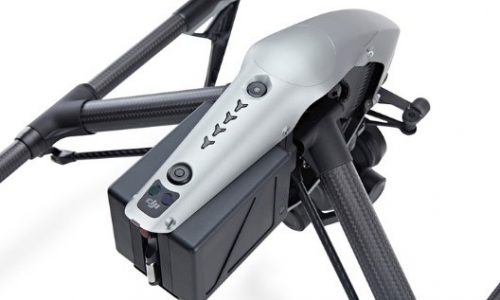
AIRCRAFT
Structure: Magnesium aluminum composite shell and transforming design, carbon fiber arms
Configuration: Vision sensing, 2-axis FPV camera, range of supported cameras.
Propulsion: 58 mph (94 kmp) max speed, 2kg of trust per rotor, 15-inch props, 23-min flight time with X7, 27-min flight time with X4S.
Battery: Dual battery, self-heating, battery redundancy, 98Wh.
IMAGE PROCESSING SYSTEM
Image processing and storage: 6K RAW @ 4.44 Gbps video recording, all-new CineCore 2.1, Integrated DJI CineSSD.
File System: FAT32/ exFAT universal file system.
Video Format: 6K CinemaDNG and 5.2K AppleProRes video support, H.265 and H.264 video codec support, 4K video at 100 Mbps. Recorded video can be stored simultaneously on DJI CineSSD and a Micro SD card.

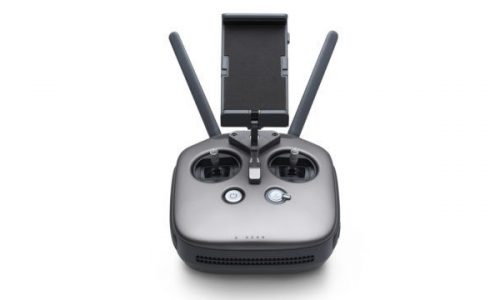
REMOTE CONTROLLER
Lightbridge technology: Signal frequency switching between 2.4 GHz to 5.8 GHz.
Controllable range: 4.3 mi / 7km (when FCC compliant)
Master-slave mode: Multiple save controller supported
Ports: Extension port, HDMI port, USB port
PROFESSIONAL IMAGE QUALITY
Zenmuse X7
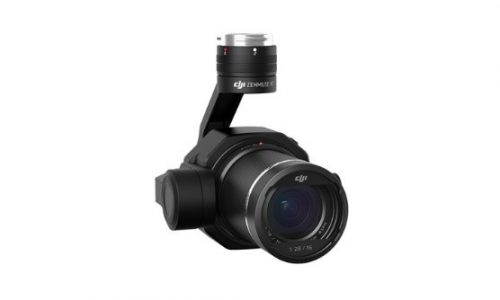
Zenmuse X5S
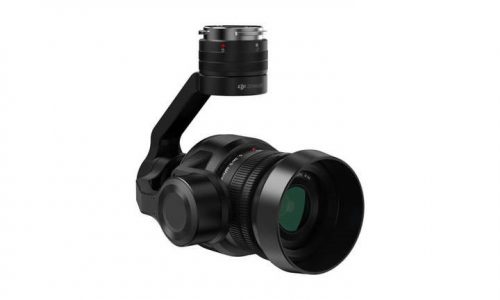
Integrated into the Inspire 2 is the brand new CineCore 2.1 image processing system, which is capable of recording video in 6K @4.44Gbps CinemaDNG, 5.2K @2.08Gbps Apple ProRes, and H.265/H.264 @100Mbps. CineCore 2.1 supports burst shots, capturing 10 JPEG + DNG bursts and continuous DNG bursts at 20fps (24MP per shot) when the Zenmuse X7 is mounted. (Currently compatible with the X7, X5S and X4S. Please refer to Specs for the supported video formats of each camera).
| 6K 30fps
CinemaDNG |
5.2K 30fps
AppleProRes |
H.265/H.264
100Mbps |
20fps
Continuous burst |
PIV |
Oversampling
Video |
|
3DNR |
3DLUT |
DJI Cinema
Color System |
EI Mode |
NVMe SSD PCle 3.0 |
FAT32/exFAT |
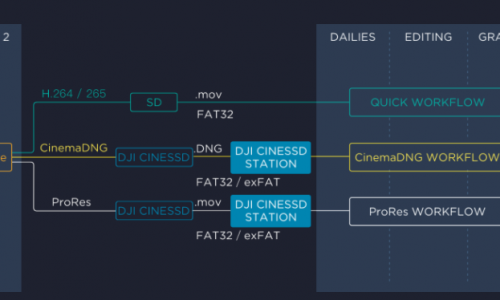
EFFICIENT WORKFLOW
The Inspire 2 creative workflow has been completely optimized and is now capable of recording video in CinemaDNG and Apple ProRes, and other common formats for post-production in filmmaking. Also supported are FAT32/exFAT file systems, which allow fast copying of files direct from the CINESSD without additional software.
SENSE AND AVOID
Forward and downward vision systems enable the Inspire 2 to detect obstacles up to 30 meters ahead, allowing for protected flight at up to 34mph (54kph) at a controllable attitude angle of 25°. Upward facing infrared sensors scan obstacles 16ft (5m) above, adding protection when flying in enclosed spaces.
Obstacle sensing systems are active during normal flight, RTH and all Intelligent Flight Modes. These sensors are core components of the DJI FlightAutonomy system, which brings the below intelligent features to the Inspire 2:
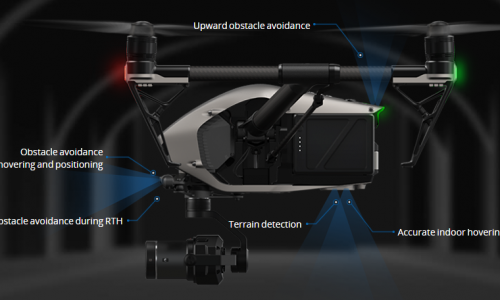
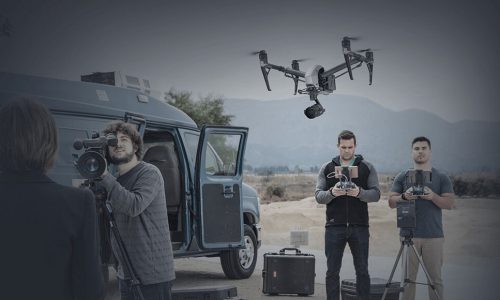
SPOTLIGHT PRO
Spotlight Pro is a powerful tracking mode that allows even single pilots to capture complex, dramatic images. It uses advanced visual tracking algorithms to lock onto a subject during flight, regardless of the direction that the Inspire 2 flies, creating shots that would once have required a dedicated camera operator. If the gimbal comes close to reaching its rotation limits, the Inspire 2 itself will rotate in the same direction without affecting flight control or the shot being captured to free up gimbal movement.
It has two shooting modes, Quick Mode and Composition Mode. In Quick Mode, select an object to begin tracking. In Composition Mode, select the subject and the tracking position. When the subject enters the preset tracking position, press the shortcut to begin tracking. The gimbal can be moved during shooting for composition adjustments. Spotlight Pro is available in Intelligent Flight Modes TapFly, Waypoint, and Point of Interest.
VIDEO TRANSMISSION SYSTEM
The latest update to DJI Lightbridge technology has an effective transmission distance of up to 4.3mi / 7km (when FCC compliant) and is capable of delivering both 1080p/720p video as well as the FPV view to pilot and camera operator. Users can also switch between 2.4GHz and 5.8GHz control frequencies to cut through noise for greater signal stability.
Master and Slave Controllers
A new wireless HD image transmission technology sends video information from the master controller to the slave controller and the two controllers can be up to 100m apart without loss of image quality.
Broadcast mode
Broadcasters can broadcast direct from the Inspire 2 using its dedicated 1080i50 and 720p60 transmission signal. Aerial live-streaming direct to TV is as simple as connecting the Inspire 2 remote controller to the satellite truck.
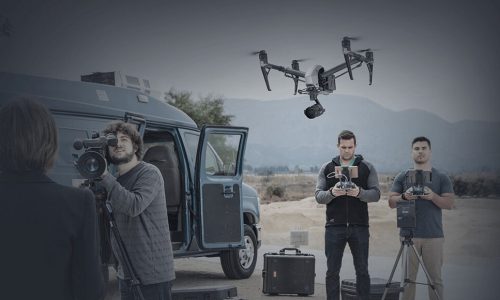
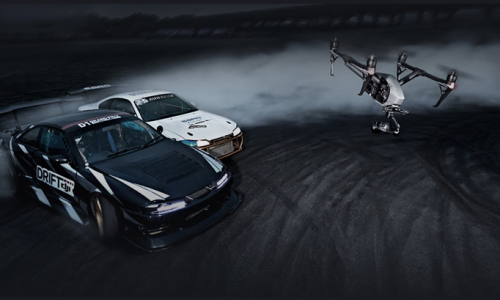
POWERFUL FLIGHT PERFORMANCE
A new propulsion system optimized for power creates a new level of flight performance. The Inspire 2 flies at up to 58mph (94kph) descends at 9m/s and ascends at 6m/s. It can accelerate from 0 to 50mph (80kph) in just 5 seconds and flies at a max attitude angle of 40°. The two controller sticks are tuned for more sensitivity, making delicate maneuvers easier. More power also allows the Inspire 2 to fly in more extreme conditions, including over 2500-5000m above sea level (using optional dedicated propellers), and in temperatures as low as -4°F (-20°C) using self-heating Intelligent Flight Batteries.
INCREASED RELIABILITY
Reliability has been further enhanced through dual redundancy of key modules such as the IMU and barometer. The intelligent flight control system monitors the redundancy system, giving it accurate flight data.
The new obstacle sensing system helps the Inspire 2 sense and avoid obstacles, minimizing the risk of collision.
Dual batteries mean that if a problem occurs on one battery the other is able to continue flight long enough for a safe landing. At the same time, the Inspire 2 propulsion system is driven a PWM signal with serial port signal redundancy so that if PWM signals are lost, transmission will continue through the serial port.
This propulsion system has been tested for thousands of hours to ensure reliability, when combined with key sensors and a dual-battery design, overall flight reliability is significantly enhanced.
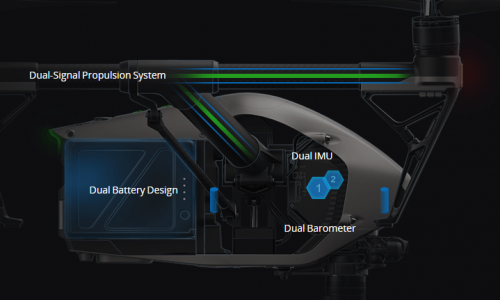

Inspire 2 Activation Key of RAW & Apple ProRes
An Inspire 2 Activation Key of RAW & Apple ProRes activates the usage permission of CinemaDNG or Apple ProRes inside CineCore 2.0. The CineCore 2.0 image processing system includes a high-performance video processor and a high-speed storage system that features a DJI CINESSD and an optimized FAT32/exFAT file system. This allows the Inspire 2 to support CinemaDNG and Apple ProRes recording. Inspire 2 Activation Key of RAW & Apple ProRes unlock these advanced capabilities for high-level filmmaking purposes.
SPECS
AIRCRAFT
| Model | T650 |
| Weight | 7.58 lbs (3440 g, including propellers and two batteries, without gimbal and camera) |
| GPS Hovering Accuracy | Vertical: ±1.64 feet (0.5 m) or ±0.33 feet (0.1 m, Downward Vision System enabled) Horizontal: ±4.92 feet (1.5 m) or ±0.98 feet (0.3 m, Downward Vision System enabled) |
| Max Angular Velocity | Pitch: 300°/s Yaw: 150°/s |
| Max Tilt Angle | P-mode: 35° (Forward Vision System enabled: 25°) A-mode: 35° S-mode: 40° |
| Max Ascent Speed | P-mode/A-mode: 16.4 ft/s (5 m/s) S-mode: 19.7 ft/s (6 m/s) |
| Max Descent Speed | Vertical: 13.1 ft/s (4 m/s) Tilt: 13.1-29.5 ft/s (4-9 m/s) |
| Max Takeoff Sea Level | 1.55 mi (2500 m) 3.1 mi (5000 m with specially-designed propeller) |
| Max Wind Speed Resistance | 10 m/s |
| Max Flight Time | Approx. 27min (with Zenmuse X4S) Approx. 23min (with Zenmuse X7) (Hovering at sea level with no wind.) |
| Motor Model | DJI 3512 |
| Propeller Model | DJI 1550T |
| Indoor Hovering | Enabled by default |
| Operating Temperature | -4° to 104° F (-20° to 40° C) |
| Diagonal Distance (propeller excluded) | 23.8 inch (605 mm, Landing Mode) |
| Max Speed | 58 mph or 94 kph (Sport mode) |
GIMBAL
| Model | ZENMUSE X4S(optional) ZENMUSE X5S(optional) |
| Angular Vibration Range | ±0.01° |
| Controllable Range | Pitch: -130° to+40° Roll: ±20° Pan: ±320° |
| Max Controllable Speed | Pitch: 180°/s Roll: 180°/s Pan: 270°/s |
| Interface Type | Detachable |
| Mechanical Range | Pitch: -140° to+50° Roll: -50° to+90° Pan: ±330° |
CHARGING HUB
| Model | IN2CH |
| Input Voltage | 26.1 V |
| Input Current | 6.9 A |
FORWARD VISION SYSTEM
| Obstacle Sensing Range | 2.3-98.4 feet (0.7-30 m) |
| FOV | Horizontal: 60°; Vertical: 54° |
| Operating Environment | Surfaces with clear patterns and adequate lighting |
REMOTE CONTROLLER
| Model | GL6D10A |
| Operating Frequency | 2.400-2.483 GHz 5.725-5.850 GHz |
| Max Transmitting Distance(unobstructed, free of interference) | 2.4 GHz: FCC: 4.3 miles (7 km); CE: 2.2 miles (3.5 km); SRRC: 2.5 miles (4 km); MIC: 2.5 miles (4 km); 5.8 GHz: FCC: 4.3 miles (7 km); CE: 1.2 miles (2 km); SRRC: 3.1 miles (5 km); MIC: – ; |
| EIRP | 2.4 GHz: FCC: 26 dBm; CE: 17 dBm; SRRC: 20 dBm; MIC: 17dBm; 5.8 GHz: FCC: 28 dBm; CE:14 dBm; SRRC: 20 dBm; |
| Video Output Ports | USB, HDMI |
| Power Supply | Built-in battery |
| Charging | DJI charger |
| Dual User Capability | Host-and-Slave connection |
| Mobile Device Holder | Tablet or Smart Phone |
| Max Mobile Device Width | 170 mm |
| Output Power | 9 W (Without supplying power to smart device) |
| Operating Temperature | -4° to 104° F (-20° to 40° C) |
| Storage Temperature | Less than 3 months: -4° to 113° F (-20° to 45° C) More than 3 months: 72° to 82° F (22° to 28° C) |
| Charging Temperature | 32° to 104° F (0° to 40° C) |
| Battery | 6000mAh 2S LiPo |
| USB Supply Power | iOS: 1 A @ 5.2 V (Max); Android: 1.5 A @ 5.2 V (Max) |
BATTERY (STANDARD)
| Name | Intelligent Flight Battery |
| Model | TB50 |
| Capacity | 4280 mAh |
| Voltage | 22.8 V |
| Battery Type | LiPo 6S |
| Energy | 97.58 Wh |
| Net Weight | 515 g |
| Charging Temperature | 41° to 104° F (5° to 40° C) |
| Operating Temperature | -4° to 104° F (-20° to 40° C) |
| Max Charging Power | 180 W |
| Storage Temperature | Less than 3 months: -4° to 113° F (-20° to 45° C) More than 3 months: 72° to 82° F (22° to 28° C) |
DOWNWARD VISION SYSTEM
| Velocity Range | <32.8 ft/s (10 m/s) at height of 6.56 feet (2 m) |
| Altitude Range | <32.8 feet (10 m) |
| Operating Range | <32.8 feet (10 m) |
| Operating Environment | Surfaces with clear patterns and adequate lighting (> 15 lux) |
| Ultrasonic Sensor Operating Range | 0.33-16.4 feet (10-500 cm) |
| Ultrasonic Sensor Operating Environment | Non-absorbing material, rigid surface |
UPWARD INFRARED SENSOR
| Obstacle Sensing Range | 0-16.4 feet (0-5 m) |
| FOV | ±5° |
| Operating Environment | Large-size non-reflective obstacles |
APP
| Name | DJI GO 4 |
| Mobile Device System Requirements | iOS 9.0 or later, Android 4.4.0 or later |

